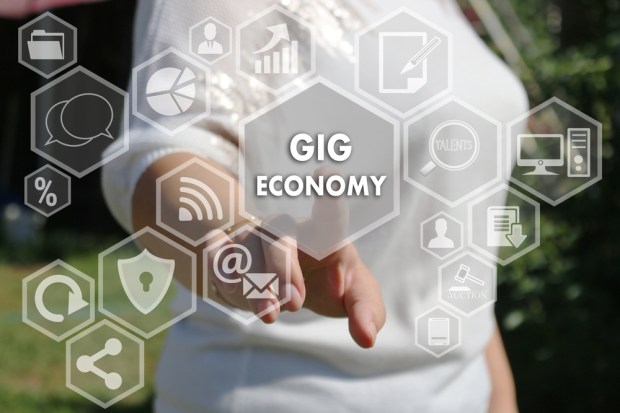The Changing Identity Of The Gig Economy Worker

With collective income slated to hit $680 billion this year, gig economy workers are a rising economic force — and one that is changing face.
Traditionally, gig workers have been viewed as unskilled professionals that fall to part-time work because they can’t get full-time jobs. But Michael Ting, SVP, Digital Markets at Hyperwallet, explored with PYMNTS’ Karen Webster the evolving identity of the on-demand workforce, and how technology contributes to that change.
“Not to use the over-said term ‘on-demand,’ but that’s literally what it is now,” Ting explained of the rise in the gig workforce. “There is so much availability and supply to meet all of the demands out there. A lot of times there has been an imbalance between supply and demand, but what’s happened is now, if you’re out there demanding something, there’s a pretty good chance you’ll be able to find the supply — and find it readily available.”
The rise in supply of on-demand work can be attributed, at least in part, to technological advancements. Those online and mobile platforms through which on-demand workers can find work, and through which clients can post a gig, enabling the supply-and-demand ball to keep on rolling.
“Before this technology, it was difficult for the two sides to discover each other, and when they did, they had to both be ‘online’ together at the same time to communicate in real-time and coordinate logistics,” Ting said. “But now, with these technology platforms, they can communicate to each other without both having to be online at the same time. It’s very flexible for both sides.”
The surge in this workforce has also led to an explosion of who comprises it.
The latest PYMNTS.com Gig Economy Index highlights just how diverse the field is, with 76 percent of gig workers having worked in the last three months reporting at least some upper-level education under their belt.
“Overall,” the report concluded, “gig employees tended to be more highly educated than the average American.”
The type of work these professionals are taking on has diversified as well. Unsurprisingly, the Index found, the most popular type of work is transportation — like Uber drivers — with 19 percent of gig economy workers reporting that they work in this area. But professional services is close behind at 18 percent, with education and healthcare also gaining strength.
In many ways, the data suggests, these employees may already have full-time jobs in their profession and are looking to supplement their income, or have chosen to turn away from full-time work in favor of a more flexible schedule. Nearly two-thirds told PYMNTS they would not give up their gig work to take on a full-time job.
“That’s a very different paradigm than before,” reflected Ting. “We used to think of the way we earn money as a 9-5 job — and that’s no longer the case. You can earn money at any time now.”
With the gig workforce continuing to grow and evolve, the definition of a “gig worker” is also in flux, Ting noted.
“When you look at the traditional definition of a small business, even National Small Business Week has a definition that is very prescribed. It’s the traditional notion of Main Street mom-and-pop,” he said. “The interesting thing about the gig economy is that these workers play a dual role — they are the byproduct of these marketplace platforms, which are creating jobs and effectively employing all of these people. But simultaneously, each one of those people, those independent workers, they themselves are a small business.”
Not every gig worker might see themselves that way though. The Uber driver working random nights and weekends for supplemental income, for instance, probably doesn’t consider herself a small business.
“I think a lot of it does depend on the job they’re doing,” Ting said of the identity of the gig worker. Those professionals who, in the past, would be forced to market their skills to individual clients — workers in fields like accounting, law or copywriting — probably view themselves as small businesses. They go out and find their own market, with online platforms making that process easier than ever, Ting said.
Key to note, too, is that being a small business and an independent worker aren’t always mutually exclusive, the executive added.
It’s more than an interesting conversation, too: the identity of a gig economy worker has significant implications with the IRS and how these professionals are taxed, as well as their access to things they may otherwise get from being a traditional employee, like benefits and retirement packages.
The exploration of how to categorize a gig worker will only continue. PYMNTS’ Index found that 47 percent of gig workers derive at least 40 percent of their income from these on-demand jobs, and with so many professionals choosing this path over full-time jobs, their current collective income — which represented 3.7 percent of total GDP last year — will probably rise. As it does, the workers, their employers, regulators and the Gig Economy tech world will be forced to continue exploring the identity of the gig economy professional to continue meeting their needs.
“It’s really interesting to understand what these workers’ perspective is, how they view themselves — as an employee, as someone who is the recipient of a job or do they actually see themselves as a small business?” Ting said. “They’re not necessarily mutually exclusive. And that perspective plays into how the rest of that ecosystem needs to serve that group.”
